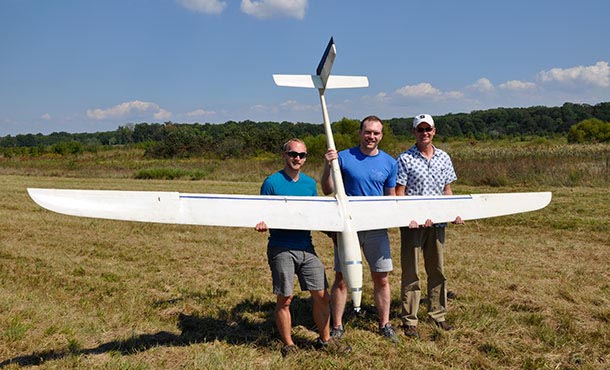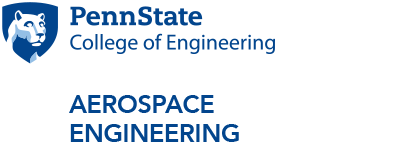
Jack Langelaan (right) and his graduate students Nate Depenbusch (middle) and John Bird (left) with AutoSOAR after a successful flight.
Autonomous flight: It's not just for the birds
Aerospace engineering researchers are going to new heights to improve the intelligence and autonomy of robotic aircraft to enable new science, military, and civil missions.
1/3/2017
UNIVERSITY PARK, Pa. — Look, up in the sky! It’s a bird, it’s a plane … no, it’s an uninhabited aerial vehicle (UAV)! And it’s starting to have a mind of its own, and an ethical one at that. At least that’s what Jack Langelaan, associate professor of aerospace engineering, and Alan Wagner, assistant professor of aerospace engineering, are working toward.
There’s no denying UAVs have soared in popularity and interest as of late, and they’ve seen unprecedented growth in their role with the military and governmental agencies. But what if they could do more—with less human intervention and more intelligence?
A bird’s-eye view
Soaring birds employ flight strategies and techniques that make use of atmospheric conditions, such as thermal updrafts, to harvest energy and sustain flight. It’s energetically less expensive than flapping and enables long migrations (Golden Eagles migrate using the updrafts found along the slopes of the Appalachian Mountains). These birds have evolved flight strategies that help them overcome the aerodynamic limitations imposed by flight physics.
By mimicking the knowledge and actions of these animals through advanced autonomous soaring systems that can search for, locate, map, and exploit thermals, Langelaan and his research group have seen significant improvements in both the range and endurance of small robotic aircraft.
Recent test flights conducted at Aberdeen Proving Ground demonstrated fully autonomous flights of several hours in duration, with the motor only running for a few minutes during the flight.
“With the goal of long endurance at low altitudes, the system extends flight times and missions far beyond what is possible with stored energy, such as batteries,” said Langelaan. “We can now take an aerial vehicle that would fly for 45 minutes and keep it aloft for as long as the weather cooperates by exploiting energy from the environment.”
Such a sophisticated system might also help you trust your local meteorologist, too. More intelligent UAVs could sample the atmosphere over a longer period of time and aid meteorology research by collecting more, and more accurate, temperature, pressure, and relative humidity data to improve weather models and forecasting. Equipped with a camera, the systems could also be used to conduct more extensive ground surveys for mapping services.
Flying in formation
Langelaan is also investigating using teams (or flocks) of autonomous multi-rotor UAVs to cooperatively carry heavy payloads.
“Using several smaller, less-expensive vehicles that can cooperate is more cost effective than building a heavy-lift vehicle,” said Langelaan. “A properly configured system of cooperating vehicles should also be more resilient to failures.”
Decisions, decisions, decisions
As robotic aircraft gain more autonomy, what decisions and actions humans should allow UAVs to make becomes increasingly important.
“If we offload more of what used to be a human’s job in operating a robotic aircraft, how we interact with the vehicle has to change dramatically,” said Wagner, who works in conjunction with the Penn State Rock Ethics Institute on the ethical dimensions of human-robot socialization and its applications to interactions between pilots and UAVs.
Safety will also be a major concern as UAVs gain more autonomy.
“If you’re carrying loads with UAVs, you don’t want to drop them on the people below or have them run into each other,” said Wagner. “You want to operate them in a way that safety, as well as the perception of safety, covers people and property on the ground and all the other vehicles in the air.”
Teaching an old bird new tricks
The surface is just being scratched when it comes to autonomous UAVs and their practical applications, whether it’s using them for search and rescue missions, landing on a ship deck, or inspecting infrastructure. One thing is for certain, though, the sky is the limit.



